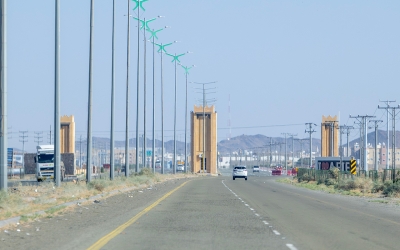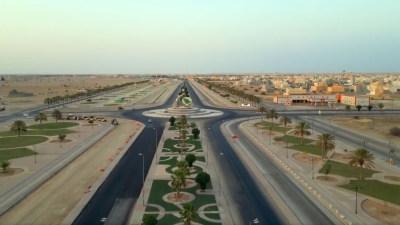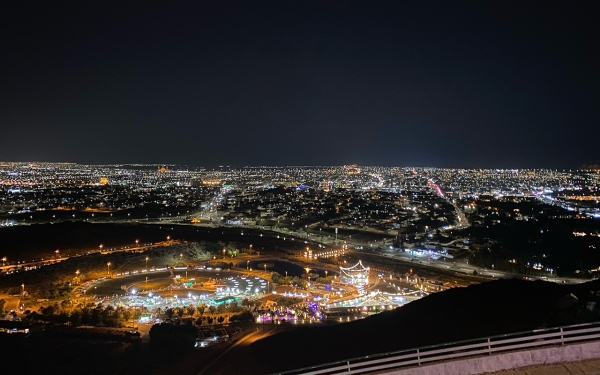
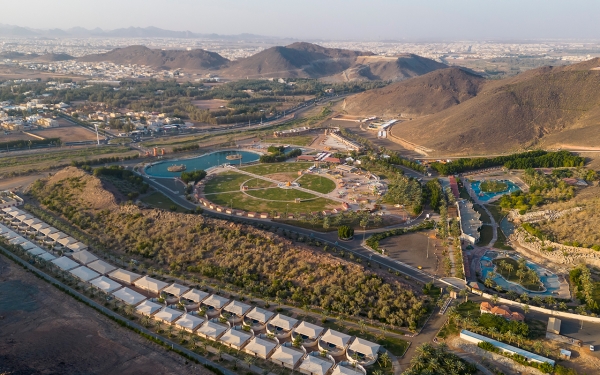
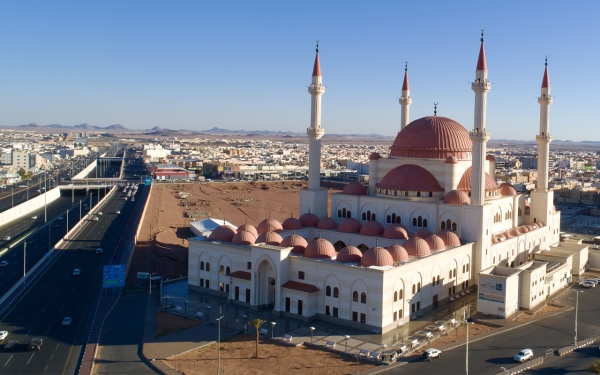
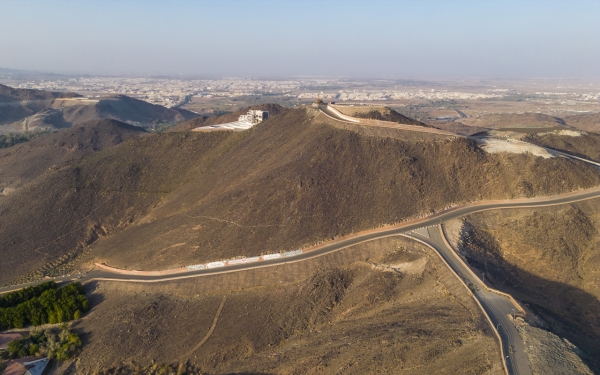
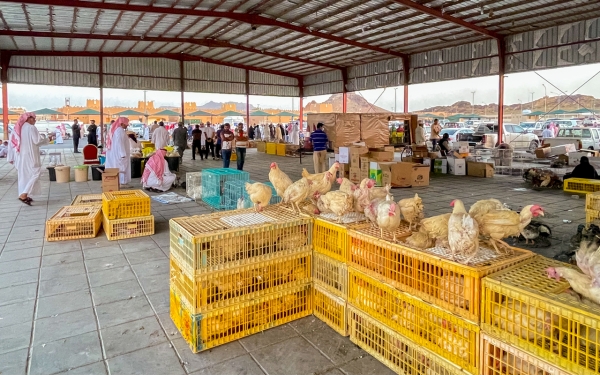
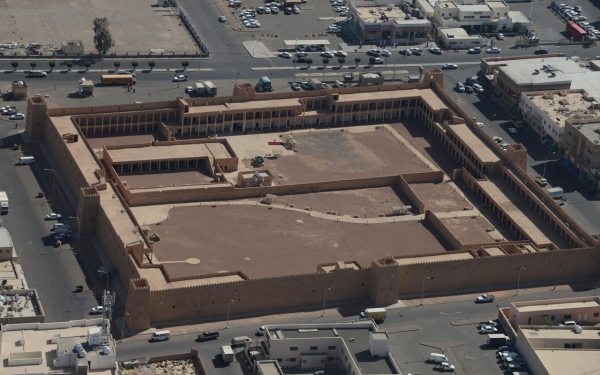
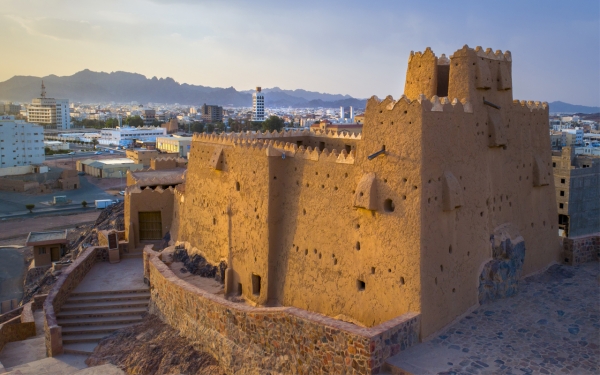
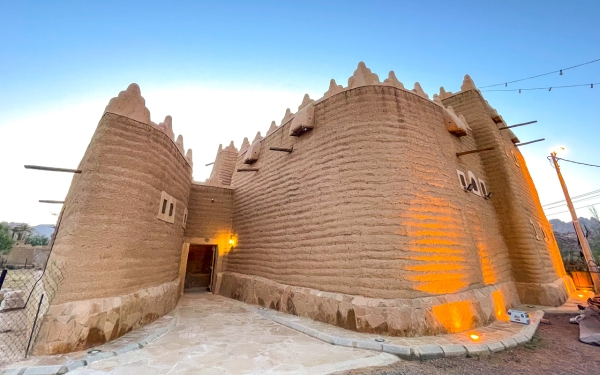
Hail City (H̱āʼil) is the administrative capital and the headquarters of the Emirate of Hail Province in the northern part of the Kingdom of Saudi Arabia. It is also the location of one of the UNESCO World Heritage Sites registered by the United Nations Educational, Scientific, and Cultural Organization (UNESCO). It is the most populous and largest governorate in the province, locally known as the Bride of the North and the Key to the Desert. It is renowned as the cradle of Arab generosity and hosts natural landmarks and archaeological sites dating back to various prehistoric eras.
Hail City
Name origin
The name Hail City is derived from its location on the western bank of Wadi al-Adira. When it rains, the water flows through the valley, forming a barrier (Hail in Arabic) and creating a connection between the residents of the two mountain ranges. The name was initially given to the valley and later became associated with the city.
Location and Borders
Hail City is located in the northern part of the Kingdom, surrounded by five administrative regions in the Kingdom: the Northern Borders Province and al-Jawf Province to the north. It is also surrounded by Tabuk Province to the north and northwest and al-Madinah al-Munawwarah Province to the south. To the south and east, it is surrounded by al-Qassim Province. Due to its central location in the Kingdom, Hail is approximately six hundred km from Riyadh, around 450 km from al-Madinah al-Munawwarah, and roughly 650 km from Tabuk. It has an elevation of about 915 m above sea level and is surrounded by two mountain ranges: the Aja Mountains to the west and the Salma Mountains to the southeast.
Hail population demographics
Hail City is a national growth center with a population of approximately 498,575 people, representing about 66.8 percent of the province's population, estimated at around 746,406 people according to the 2022 Saudi Census.
Hail weather
The climate in Hail Province is continental. It is extremely hot during the daytime in the summer, with temperatures ranging from thirty to forty degrees Celsius. At sunset, the climate gradually becomes milder. In the winter, the weather is cold, with temperatures ranging from five to fifteen degrees Celsius and sometimes dropping below freezing. Rainfall occurs in Hail during the winter and spring seasons. Throughout the year, the province experiences winds from various directions, with an average speed of not more than ten km/h.
Agriculture in Hail
Hail is a major agricultural hub in the Kingdom, known for its fertile land that produces several agricultural crops, including potatoes in commercial quantities. The Ministry of Environment, Water, and Agriculture invests in Hail through eleven agricultural projects and six others that encompass environmental, agricultural, and water-related initiatives. Despite being an inland city without direct access to the coast, Hail is characterized by geographical variations and diverse geological formations. These features provide the agricultural regions in the city with essential resources such as water, food, and fertile soil.
Urban pattern in Hail City
The urban pattern in Hail City forms an elongated strip frame extending from north to south, with a focus on the central area of the historical urban strip, which represents the city's origin. The central area contains historical buildings, including the public market in the city center, the historical Qishla Palace, heritage buildings, and historical castles. These urban landmarks have added significance to the central area of the city and have played a cultural and architectural role in Hail. Various uses dominate the overall character of Hail City, including residential, commercial, educational, religious, sports, governmental, and others.
The central area of the city predominantly carries a historical character and the main streets of the city display signs of development and modernity. The industrial area is located in the south of the city, while the Northern Province is dominated by residential neighborhoods and major projects, including Hail University, the northern suburb, and the economic city. In general, the visual identity of Hail City is characterized by a historical character in the central area, while a modern character prevails in the southern and northern provinces.
Historical Overview
Hail City in Stone Ages
Hail’s strategic location has made it a main stopover on the ancient pilgrimage and trade routes. It served as a historical crossroads for some of the most significant trade routes from and to the Arabian Peninsula. In its northern province lies the site of Jubbah, one of the UNESCO World Heritage-listed sites. This site houses rock inscriptions and artifacts dating back approximately ten thousand years on Jabal Umm Sinman. These drawings are inspired by human and animal forms, representing a record of the natural life that prevailed during that period. The form and technique of these drawings varied in each historical era, starting with large-scale rock engravings and evolving into smaller-sized symbols. During the Bronze and Iron Ages, between 1500 and 500 BCE, they transformed into symbolic inscriptions, and the Thamudic scripts comprised the majority of these inscriptions, along with traces of a historical lake at the mountain's foothill.
Hail in the era of ancient kingdoms
This period began in the first millennium BCE, and Hail was one of the centers of ancient civilizations that coexisted with the Assyrians and Babylonians, who inhabited northern Arabia. Historical sources suggest that Hail had close relations with al-Jawf and served as a rear defense line for the city of Adumatu (Dumat al-Jandal) when northern forces invaded it. This is substantiated by ancient inscriptions and rock carvings from various tribes, like Thamud and Safa. These historical artifacts now represent an attractive tourist heritage. These ancient rock inscriptions and carvings can be found in abundance in several locations around Hail, including the sites of Jubbah, Jannin (located approximately seventy km northeast of Hail city), Jabal Yatib (east of Hail city), al-Mulayhiah (thirty-five km east of Hail), Sabahah (fifty-two km north-northeast of Hail), al-Hueit, and Jabal al-Qaid, as well as throughout the Nafud Desert, al-Khutah Mountain Range, and the Ghotah.
Hail City is historically associated with the famous figure known as Hatim al-Ta'i, a symbol of generosity, kindness, and noble morals in Arab memory. Hail was the homeland of his tribe, Tayy. Hail is also connected to the ancient historical routes of trade caravans and pilgrims that linked the eastern and central regions of the Arabian Peninsula with its northern regions. These routes thrived during the period between the fifth and first centuries BCE. The importance of Hail decreased after the Nabatean Kingdom gained prominence in al-Jawf Province. It was during this time that the Tayy tribe arrived in the area and settled there between the first and second centuries BCE.
Hail City in the Saudi era
Hail City entered Saudi rule in all three of its phases. Since the establishment of the first Saudi state and the unification of parts of Najd, Hail joined Saudi rule early in 1749 and remained under it until the end of its rule. Then, the second Saudi state was founded by Imam Turki Bin Abdullah Al Saud in 1825, and two years after its establishment, Hail was among the cities that sent a delegation from its residents to Riyadh to pledge allegiance to Imam Turki Bin Abdullah and come under the banner of the second Saudi state. After the establishment of the Kingdom by King Abdulaziz Bin Abdulrahman Al Saud, he initially attempted to incorporate Hail into his rule. During that period, there were battles on the outskirts of the city with al-Rashid rulers of Hail at the time. These battles ended with a peace treaty between the two parties, which was later violated. King Abdulaziz then sent forces to Hail, which besieged the city for two months until it surrendered and joined his rule in early 1922.
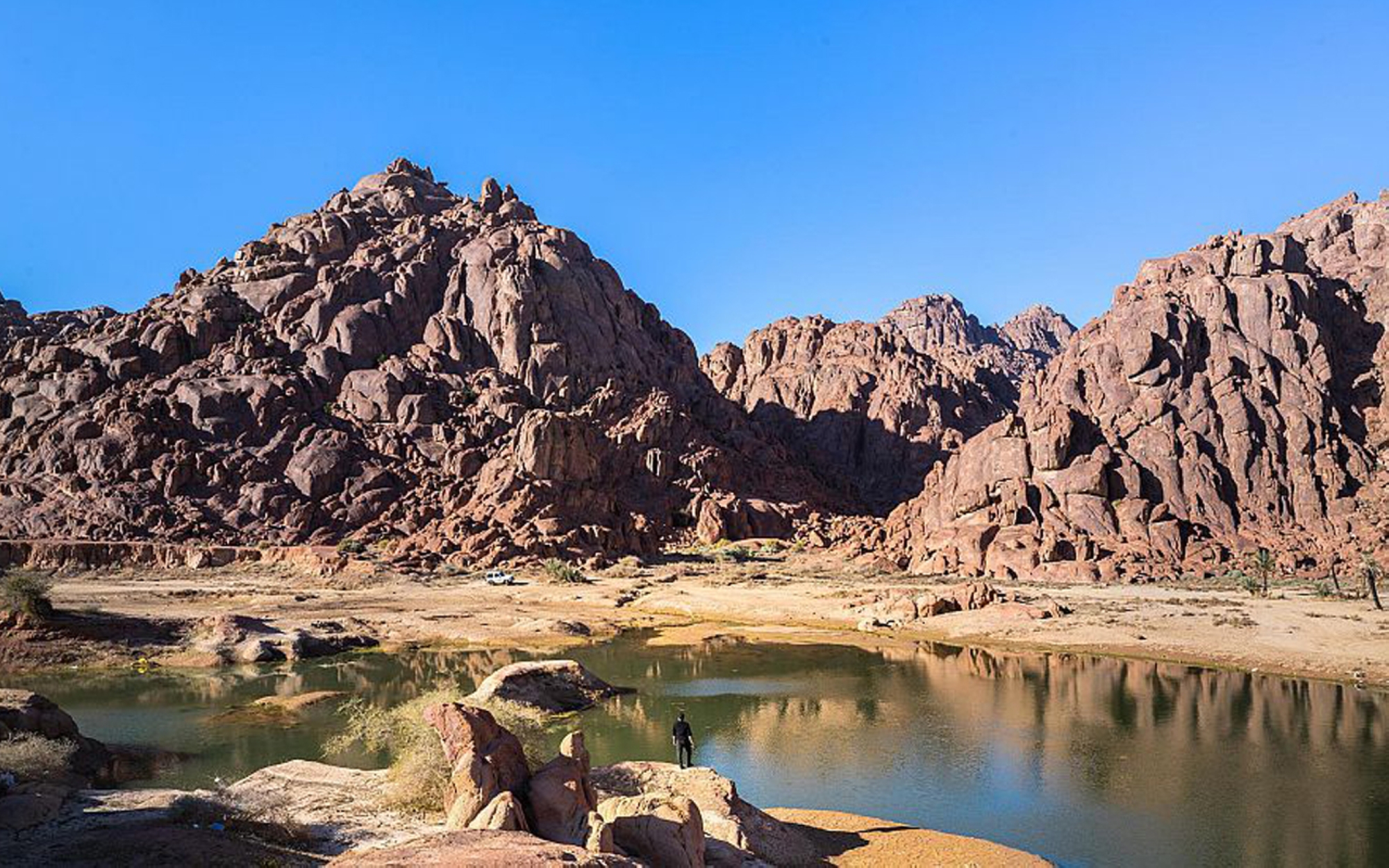
Natural and archaeological landmarks
Aja and Salma Mountains
They are two separate mountains that are considered among the famous natural landmarks in Hail City, known for their abundant palm trees and water springs. The Aja Mountains extend to the northeast for approximately one hundred km and include several small villages and water springs. The highest peak in these mountains reaches more than 1,350 m above sea level. The nature of these mountains is characterized by rugged rocky formations with sandy plains in the valleys, such as Wadi al-Uqda, which is covered with farms and fruitful orchards. It serves as a grazing area for livestock and camels. Additionally, there is the village of Tuwarin, located deep within the Aja Mountains to the north, which houses the remains of Hatim al-Tai's palace, one of the most important tourist attractions in the province.
As for the Salma Mountains, they begin in the northeastern part of Hail City and extend to the southwestern part, with a length of over sixty km. The highest peak in these mountains reaches approximately 1,200 m above sea level. The site includes several springs, farms, and towering volcanic craters, such as the Darah Crater in the eastern part of the province. After rainfall, it becomes covered in greenery along with the surrounding mountains, making it a destination for residents of the province and its visitors to enjoy picnics and leisure activities.
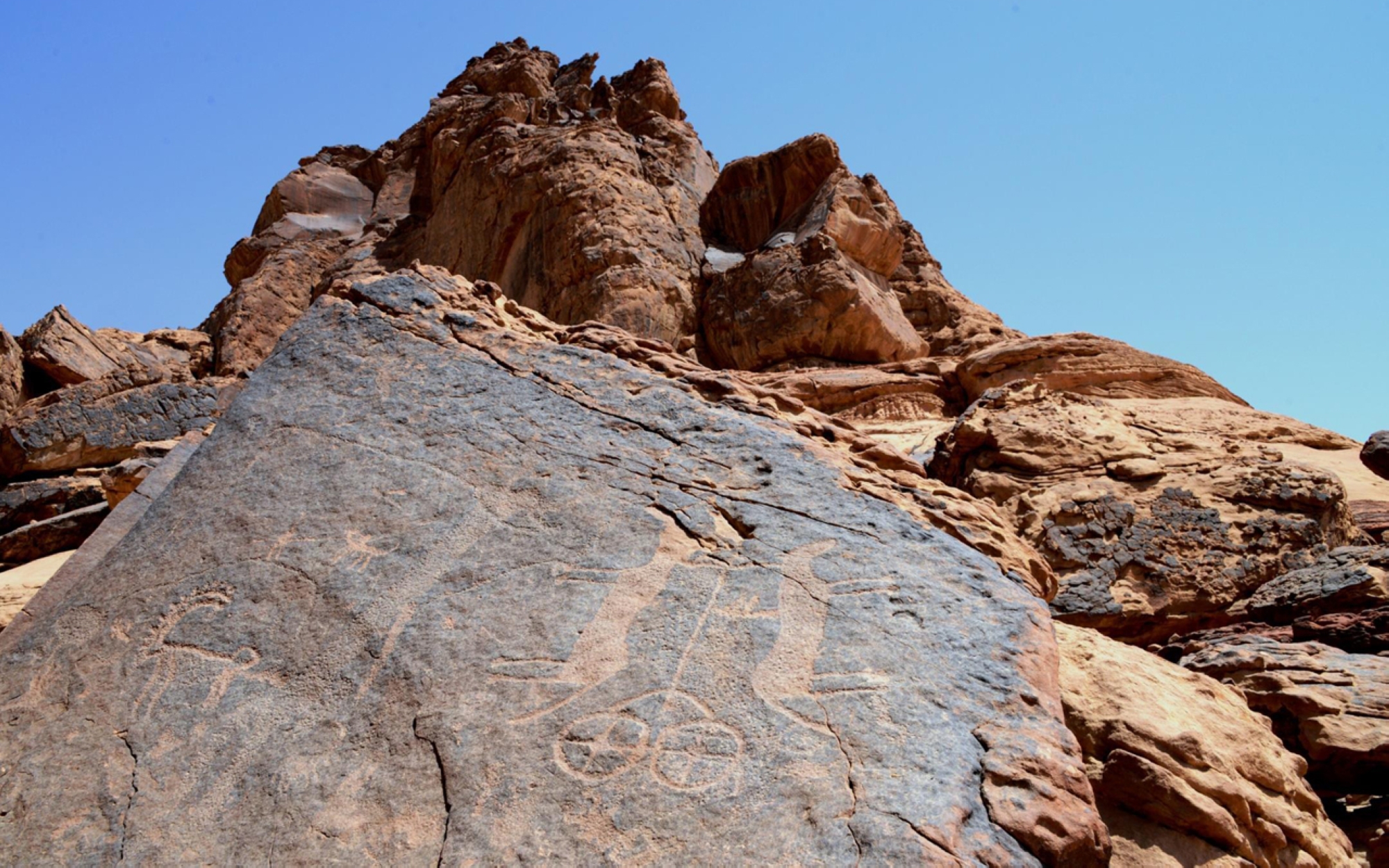
Rock art in Jubba (Jabal Umm Sinman)
Jubba is located within the southern part of the Nafud Desert, one hundred km northwest of Hail City, and the rock art area in Jabal Umm Sinman, which was registered as a UNESCO World Heritage Site in 2015, in addition to Jabal Ghotah. It embraces hundreds of drawings and rock inscriptions, representing an early style of carving and engraving on rocks dating back to the seventh millennium BCE. Jabal Umm Sinman is famous for the numerous Thamudic inscriptions and drawings on its facades. Its name, which translates to the Mother of Two Humps, derives from its resemblance to a two-humped camel resting on the ground. Approximately 5,431 Thamudic inscriptions and 1,944 drawings of various animals have been recorded on the mountain, including 1,378 drawings of camels of various sizes and shapes. Additionally, there are 262 human drawings.
The drawings and inscriptions on the two mountains contain rich scenes of the daily lives of humans and animals who settled in this area. Historically, the inscriptions are divided into two periods: The first dates back to the seventh millennium BCE, featuring complete human figures with slender arms and highlighting a corpulent body at the thighs. It showcases forms of women with braided hair and decorated skirts alongside some animal figures, such as camels, wild horses, and ibexes, as well as various groups of sheep, cats, and hunting dogs. The second period dates back to the Thamudic era, and its most prominent drawings and rock inscriptions depict the domestication of camels, showing scenes of warriors on their backs wielding swords. Ibexes, cheetahs, and ostriches are also depicted, in addition to symbolic forms and palm trees.
Yatib Mountain
Yatib Mountain is a tourist site located thirty km east of the city of Hail. It is an archaeological site with a history dating back to the third millennium BCE. The significance of the site lies in its inclusion of a collection of various rock drawings and engravings, which largely represent scenes from the daily life that prevailed during that period. It is approximately 150 m in length and contains 154 North Arabian inscriptions, predominantly memory inscriptions. Notably, among them are two inscriptions: the first was written by a woman named Nuha Bint Fasah, and the second inscription mentions the author, Nawfal Bin Umayl, expressing feelings of longing and love for his beloved.
Alongside the written inscriptions, the site is rich with animal drawings, including sheep, cattle, camels, and horses. Some are depicted as life-sized, while others are represented with chubby bodies, indicating the abundance of vegetation and pasture at the time. Artistically, the ancient artist attempted to depict the movement of the animals, and perhaps what most distinguishes the Yatib site is the abundance of palm tree drawings, which reflect the agricultural wealth that the province possessed during that period.
Uqdah touristic village
Uqdah Touristic Village is located amid the Aja Mountains west of Hail and dates back thousands of years. It is situated fifteen km from Hail City and is surrounded by a large stone wall built in the middle of the valley to prevent floods from leaving the village and to utilize them. Later, the wall was demolished and replaced with three dams to preserve the seasonal rainwater. Uqdah Village is renowned for its abundance of palm groves, springs, wells, and dams, which are the terminus for the flood streams of Wadi al-Adayra. It is referred to as Hail's food basket, given the variety of agricultural products it offers, such as dates, mint, melons, squash, grapes, apples, pomegranates, and apiaries for producing local honey.
Uqdah Village is considered one of the prominent resorts and parks in the province, distinguished by its fresh, sweetened water and the beauty of its soil. Its farms produce various types of citrus fruits. Known for its cool evenings in the summer, its proximity to the city, and attractive natural places, it has become a destination for leisure seekers and visitors from within Hail and beyond. According to the villagers, in the past, access to the village was only possible through a small passage between two mountains called al-Nasheeb. Camels loaded with provisions used to pass through it to and from the village, and the residents used it for their travels to Hail City, which is fifteen km away. Old cars used to take a long time to pass through this narrow, winding passage. The passage is about three m wide, narrows to about two m, and is approximately twenty m long.

Cultural heritage in Hail City
Popular dishes
Hail has been famous since ancient times for its popular dishes, which are still made to this day as main dishes for occasions and family gatherings. These include: al-Maqshush, which are small loaves made from wheat dough, grilled on charcoal or in ovens, and to which ghee, honey, molasses, or sugar are added; al-Hareesah, made from crushed hard wheat, cooked with meat and flavored with spices, yogurt, and ghee; and al-Klijah, a type of sweetened pastry made locally from hard wheat flour, to which some spices are added, then dipped in ghee with molasses or sugar, then grilled and dried.
Jareesh is made from crushed wheat or corn, and it is cooked with milk, meat, vegetables (al-afadiyah), spices, and ghee. There is also Thareed, which is thick bread made from wheat, moistened with ghee and pieces of onion. During the truffle season, or what is locally called Faqaa, it is mixed with them. There's also Haneeni, which consists of three ingredients: wheat bread, luxurious dates of excellent types, and added rural ghee; some of them are mixed until they blend perfectly, then eaten. There's Sabbib or Qurs, often called Qursaan; all are names for one item, which is thin bread made on a plate, moistened with meat and vegetable broth. Additionally, there's Marqooq, which is large, thin dough flakes cooked with meat pieces, vegetables, or both.
Crafts and handicrafts
Hail Province is renowned for its crafts and handicrafts, some of which are still practiced and then sold in the city's markets. Among them is the textile industry, which relies on local raw materials such as sheep wool and camel fur. The wool is sheared, collected, and spun into yarn, which is then woven in artistic ways to create several products, such as the Bedouin tent, lining, Bidi, Sahah, Nut’, and more. Hail is also notable for its wicker industries, which depend on raw materials from palm fronds and are characterized by their diversity and abundance. The most common item is the mat, which is used for sitting or praying, followed by food covers, wicker bags of various types and sizes, large serving plates, brooms, hats, and fans. The demand for wicker products rises as the craftsman innovates in the aesthetic aspects of the products, particularly in the drawings and engravings that they create in the products they make.
Hail is renowned for its carpentry craft and wooden products, such as making the wooden boxes for which it is famous and producing incense burners wrapped in sheets of copper or aluminum, distinguished by the art of geometric decorations. This extends to making chairs, beds, and more, which are in increasing demand within and outside the province. Hail is also known for producing Dallahs, which are specialized metal containers used for preparing coffee in the Kingdom. Hail Province is almost uniquely localized in manufacturing high-quality types, varied in their sizes and shapes. Copper is a fundamental material in the manufacture of the Dallahs. Notably, the Haili Dallahs, named after Hail Province, are among the most famous throughout the Kingdom.
Just as Dallahs for coffee are associated with Hail, the province is also connected to the manufacture of other coffee utensils for several reasons, the most important of which are the traditions for which the people of Hail have been known since ancient times, such as generosity. Among the most famous coffee tools in Hail are the Najr, the Mahmas, coffee coolers, al-Shat, and others. Another handicraft industry is the making of Nadafa, which many craftsmen still practice in the old neighborhoods in the center of Hail City. It is also called Qattana and upholstery, and it includes stuffing certain types of furnishings with cotton, Tarf plant, Rufa, and others. Additionally, there is the manufacture of leather products practiced by craftsmen in various locations in Hail City, with its most famous products being shoes, bags, water containers, leather vessels, sheaths, and various types of belts.
Craft industries related to excursion necessities are active due to the well-known interest of the people of Hail in desert trips. These include the production of tents, stakes, ropes, and trip tool bags, along with industries related to the desert environment, such as the maintenance of light weapons and air rifles for hunting.
Architectural heritage
Al-Qishlah Palace
Al-Qishlah Palace is one of the famous architectural heritage sites in the center of Hail City. Its significance stems from its location at the heart of the historical and commercial center of the city. The palace was built during the reign of the founding King Abdulaziz Bin Abdulrahman Al Saud in 1941. Initially, it was constructed as a military fort used for army preparation and as a security headquarters. The building is rectangular and consists of two floors, covering an area of 19,832 m. The palace was built using clay, mud bricks, and stone, following the architectural and decorative style known in Najd Province. Its external walls feature eight cylindrical defensive towers. The palace has two large gates, one in the middle of the eastern facade of the building, surrounded by numerous decorations, and the other on the southern side, which is the entrance designated for visitors. Inside, there is a mosque and several rooms adorned internally with plaster decorations and engraved and colored doors and windows.
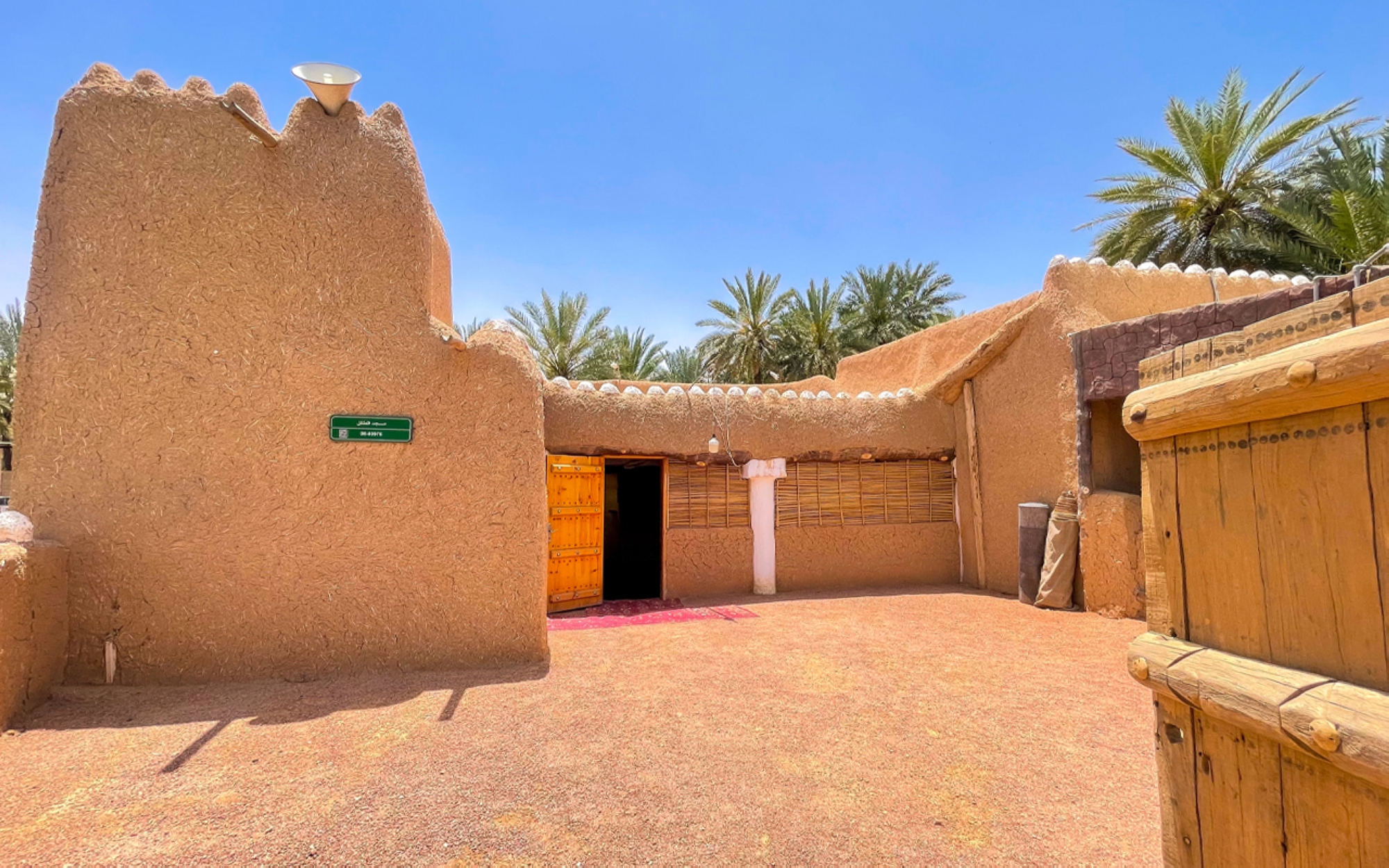
A'arif Fort
A'arif Fort is located in the center of Hail City, perched atop a mountain that overlooks the city from the south. It is believed to have been constructed in 1840, and its construction was expanded in 1890. Built of stone and mud before the Saudi era during the rule of Al Ali family, it was expanded during the era of Al Rashid family. In its architectural style, it does not differ from the known defensive buildings in the architecture of the Kingdom's central province.
Touristically, A'arif Fort is considered one of the significant cultural archaeological landmarks in the province that can be visited and enjoyed. Its importance lies in its architectural formations, general appearance, and strategic location in the city, as it overlooks all the landmarks of Hail City. Through it, one can observe the farms, markets, and surrounding heritage neighborhoods, such as Labdah and Sarha neighborhoods, among others.
The fort was built with stone foundations and walls, and it was distinguished by its interior and exterior design and its perfect components, such as windows and doors. Therefore, A'arif Fort forms one of the distinctive icons of Hail City because it is easily visible from all parts of the city. The fort consists of an entrance on the southern side that opens towards the east and leads to a small courtyard, which in turn leads to the entrance of the mosque located in the center of the castle. It also includes some passageways leading toward the southwest. The mosque contains a single arcade with a row of five columns. To the east of the mosque, there is a stairway leading to a circular tower that is more than five m high. The tower contains a set of observation openings and balconies at its top, which are stepped in height and harmonize with the shape of the mountain on which it is built.
Barzan Palace
It is a historical palace and one of the famous heritage landmarks in Hail. It was named Barzan because it was prominent (Bariza in Arabic) among the buildings constructed during the period of its establishment. The palace, built of mud, has been present at political events and occasions in Hail Province. Some parts of the palace have been demolished, and only the two towers that surrounded it remain today. The diameter of the northern tower is about seven m; the southern tower is five m in diameter; and both are ten m high.
Rashid Bin Leila Palace
It is located in the center of Hail City, in the historical Labdah district. It spans an area of 1,586 m and consists of two floors and a large external courtyard with a small farm. The palace encompasses all the components of the traditional heritage house that are still in good condition, such as the coffee area, al-Wijar, al-Samawa, corridors, and al-Sharaneef. Stones were used in constructing its pillars and in establishing the walls, which were built with mud and pre-prepared brick in wooden molds. Trunks of Tamarisk trees and palm fronds were used to construct the roof, and it features some ceilings of polished wood, which were established in later periods. The palace is distinguished by doors and windows made from Tamarisk wood, engraved with bright-colored decorations. Internally, it is characterized by exquisite artistic engravings executed in plaster to form artistic panels of geometric and script decorations.
Historical neighborhoods
Cultural tourism landmarks in Hail include its heritage neighborhoods. They embrace a collection of distinguished sites that constitute the historical center of Hail City and stand as a testament to its rich past. The historical center consists of three traditional neighborhoods that have given the city its heritage character: al-Ulaya district, the Labda district, and the Sarha district. All of them are characterized by the traditional architectural and decorative style of their buildings and their architectural fabric on the level of Hail Province. Despite the intertwining of modern buildings with traditional ones in these neighborhoods due to urban development, the remaining buildings represent a unique model of traditional architecture. Among the most important of these are the palaces and homes of gold traders in Hail, where traditional architecture and decoration are prominent in the reception rooms, which are called Majalis. They are adorned with plaster and wooden decorations, executed in various artistic methods, such as engraved carving, embossing, and coloring decoration (fresco).
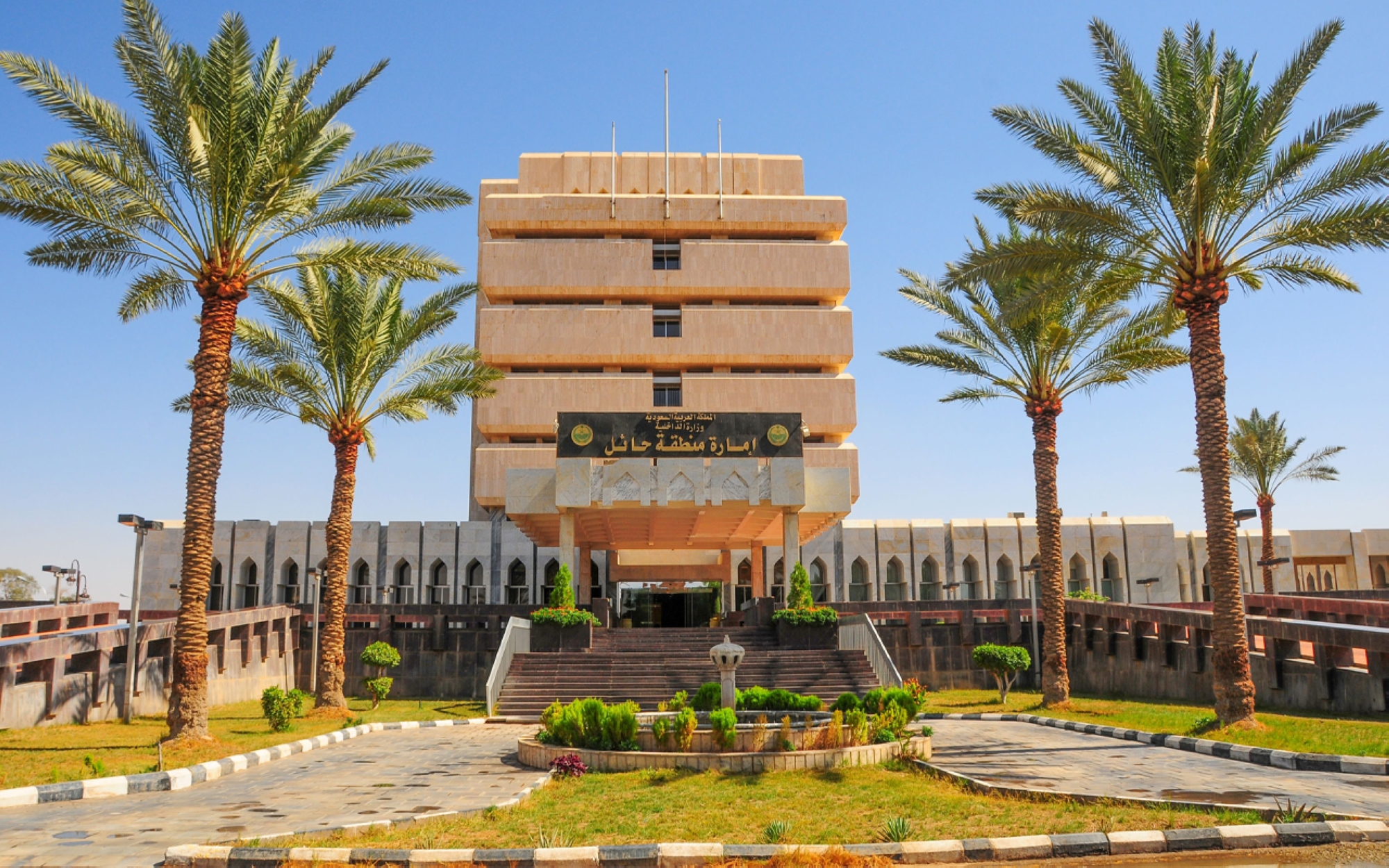
Government facilities in Hail City
Emirate of Hail Province
Hail City hosts the headquarters of the Emirate of the Province, which is the entity responsible for representing the Custodian of the Two Holy Mosques in the province. Organizationally subordinate to the Ministry of the Interior, its responsibilities include coordinating and participating with governmental entities in planning stages to provide all services to citizens and residents. Additionally, it deals with receiving complaints, addressing their issues, and working to meet their demands and solve their problems. It is located on Prince Muqrin Bin Abdulaziz Road, which is about eleven km away from Hail Airport. The visual identity of the Ministry of the Interior serves as its logo.
Hail Province Municipality
It is concerned with developing Hail Province to achieve sustainable development in its urbanization and the quality of its facilities and services, in addition to directing the urban development of cities, villages, and settlements in the present and future. Among its responsibilities are to provide services that ensure environmental health and provide safety and well-being for the inhabitants. Hail Province Municipality is organizationally affiliated with the Ministry of Municipalities and Housing, and its headquarters is in the center of Hail City. It is 1.7 km away from the headquarters of the province's emirate, and it has seventeen municipalities under its administration, including Anbuwan Municipality, al-Ajfar Municipality, Faid Municipality, al-Hulaifa al-Sufla Municipality, al-Shinan Municipality, Sumaira Municipality, Moqqaq Municipality, al-Kahfa Municipality, al-Shamli Municipality, and al-Rawdah Municipality.
The history of its establishment dates back to 1961, during the reign of King Saud Bin Abdulaziz Al Saud. It was named Hail District, and Sheikh Mamdouh Bin Sulaiman Al Ali was appointed the first president of Hail District. During the reign of King Abdullah Bin Abdulaziz, a decision by the Council of Ministers was issued on August 30, 2007, to change the name of Hail Province District to Hail Province Municipality. The municipalities in Hail Province are affiliated with the Secretary of Hail Province. The first secretary for Hail Province to be appointed was Dr. Abdulaziz Bin Yusuf al-Ammar.
The Chamber of Commerce and Industry
A non-profit entity, it is one of the twenty-eight chambers of commerce and industry distributed in the cities of the Kingdom and a member of the Saudi Chambers Council. Its headquarters is located in Hail City. It works to develop commercial activities in the province and represents them with ministries, authorities, and public institutions, working to protect and develop them. The logo of the Hail Chamber consists of three elements: the palm tree, a symbol of giving; an Islamic decoration frame that expresses authenticity and belonging; and a symbolic terrain composition that symbolizes the Aja and Salma mountains.
The Chamber of Commerce and Industry in Hail was established on January 21, 1982. It possesses a juridical personality and enjoys financial and administrative independence. It is linked to the Ministry of Commerce. The chamber consists of a general assembly, a board of directors, and a general secretariat. The Hail Chamber of Commerce aims to develop the economic and business environment by activating strategic participation between it and its members and supporting and considering their interests. It also develops the working environment of the chamber, contributing to the development and growth of the chamber's relationships with the surrounding community. Furthermore, it aims to achieve financial balance to ensure the continuity of its activities, mandates, and plans.
Education and Culture
The beginnings of education in Hail
The beginnings of education in Hail City relied on the reading of the Quran and religious sciences taught by the city's teachers at graded levels, including primary, intermediate, and high levels. In 1934, the first private school was opened, followed by the opening of the first regular school, which is the Saudi School in Hail. As for the formal education in Hail City, it began with the opening of the Saudi School in 1937, which was the first formal school in the city and at the level of Hail Province at that time. In 1949, a second school was opened, named al-Aziziya School, followed by the opening of more schools and the development and spread of education in Hail and its villages.
University of Hail
The University of Hail, abbreviated as UOH, is one of the public universities in the Kingdom. It was established in 2005. The nucleus of the current university is Hail Community College, which was established in 1998. Initially, the college was affiliated with King Fahd University for Petroleum and Minerals and remained in this condition for seven years until it became independent under the name University of Hail. The University of Hail comprises fourteen colleges with varied specializations across scientific, health, engineering, administrative, humanities, and community fields. It also embraces more than twenty thousand male and female students, accompanied by 2,100 faculty members, according to the statistics provided on the university's website.
The university is keen on scientific research. Represented by the College of Medical Sciences, it won two excellence awards for scientific production among Saudi universities in global databases. These are the Saudi Digital Library award for the highest impact scientific production in the Scopus database and the Saudi Digital Library award for the most productive scientific output in the same database.
The Literary and Cultural Club in Hail
The Literary and Cultural Club in Hail is one of the cultural and literary institutions in the Kingdom. It was established in 1994 with the aim of nurturing literary talents and guiding them towards proper literary practices. Additionally, it seeks to create a cultural and literary platform for the residents of Hail Province, enhance cultural activities, and promote their development and growth. Hail Literary Club works on publishing literary works and printing cultural books in service of its objectives and to support cultural activities. It aims to organize literary and poetic lectures and seminars and host prominent figures in poetry and literature from within and outside the province. Additionally, the club actively participates in literary conferences, book fairs, and national and international events and sponsors cultural competitions in various literary fields such as novels, short stories, and poetry.
Hail Literary Club has been dedicated to organizing lectures, seminars, and literary events throughout its history. It has also published a number of significant books in the fields of culture and literature. Additionally, the club has established a partnership with Dar al-Intishar al-Arabi in Beirut for joint publishing, aiming to enhance the production quality of its publications and improve their distribution. One of the notable achievements of Hail Literary Club is the establishment of the Hail Novel Prize, which attracts specialized novelists and writers in the field of novel writing. The club also publishes a specialized magazine called Ru'aa, which hosts poets and writers and organizes press and cultural meetings with them. Additionally, the club organizes the Hatim al-Tai Forum, which includes various cultural and literary events.
Hail Regional Museum
Hail Regional Museum is one of the museums in the city of Hail. It is located in al-Buhaira neighborhood and is designed in the traditional architectural style of the Hail Province. The museum was opened in 2020, coinciding with the launch of the tourism season in Hail. It covers an area of twenty thousand m and includes eight halls, each of which tells a different historical period in the development of the Hail Province. The museum also contains a significant collection of archaeological artifacts and ancient manuscripts. Additionally, it showcases models of traditional industries that Hail is known for, such as clothing, cooking utensils, and agricultural tools.
Transportation in Hail City
Hail International Airport
Hail Airport was established in 1974. It is located five km away from the center of Hail City, with a capacity to accommodate five hundred thousand passengers. The airport offers all the ground services provided by the operating companies to meet the needs of passengers. The importance of the airport lies in its strategic location near the economic center, at a convergence point for international air routes. The airport features a passenger terminal covering an area of approximately four thousand m, divided into three different halls: an arrival hall spanning 867 m, a departure hall of 11,238 m, and a hall for VIPs, first-class, and business passengers. Additionally, the airport includes several support facilities and buildings.
Related quizzes
Related articles

